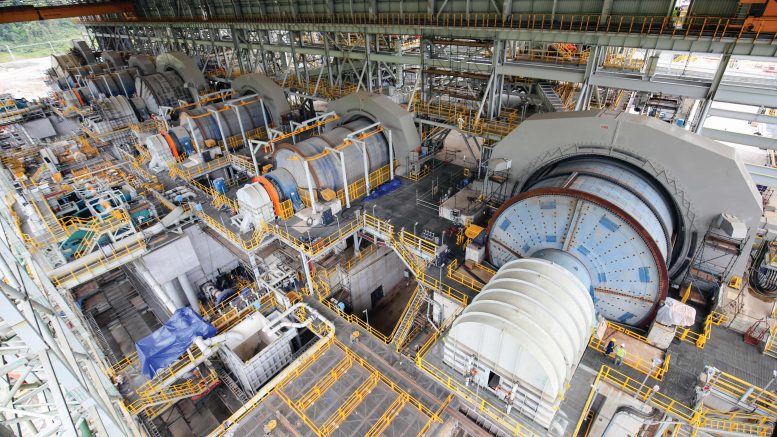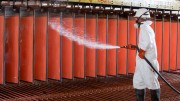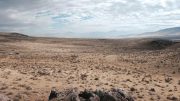As a new year approaches, The Northern Miner runs down 15 of the most interesting new mines scheduled to begin production in 2019.

The processing plant under construction at Lundin Gold’s Fruta del Norte gold mine in southern Ecuador in November 2018. Credit: Lundin Gold.
Fruta del Norte (gold)
Lundin Gold
The Fruta del Norte saga has been as dramatic as any in the industry. In 2006, Aurelian Resources discovered the gold deposit in Ecuador before selling it to Kinross Gold in 2008 for US$1.2 billion. In 2014, after years of disputes with the Ecuadorian government over proposed taxes, Kinross would sell the project to Lundin Gold (TSX: LUG) for US$240 million.
Lundin seems set to make good on its contrarian investment in Ecuador. The company is scheduled to hit its long-held target of 2019 for first production, recently completing 34% of the US$692-million construction effort. It plans to reach the orebody in the first quarter of 2019 and achieve its first gold pour by the fourth quarter.
Lundin aims to produce 4.6 million oz. gold over 15 years at Fruta del Norte, with all-in sustaining costs at US$609 per ounce.

Primary crushers and a conveyor at First Quantum Minerals’ Cobre Panama copper mine under construction in Panama. Credit: First Quantum Minerals.
Cobre Panama (copper)
First Quantum Minerals
First Quantum Minerals (TSX: FM) plans to cut the ribbon in 2019 on its Cobre Panama open-pit copper mine, 20 km from the Panama coast.
The massive development with a US$6.3-billion price tag is more than 80% complete, according to the company’s latest update. For 2019, First Quantum expects to deliver the first ore to the processing plant and ramp up to 74 million tonnes per year (annualized). The miner is targeting 150,000 tonnes of copper-in-concentrate production for 2019.
The mine should reach nameplate throughput of 85 million tonnes per year in 2020, and could expand to 100 million tonnes per year after 2022. First Quantum expects all-in sustaining costs of US$1.50 per lb. copper produced.
Measured and indicated resources total 3.68 billion tonnes grading 0.37% copper, and the company expects mine life to exceed 40 years.

A rig drilling the first well at Excelsior Mining’s Gunnison in-situ copper mine in Arizona. Credit: Excelsior Mining.
Gunnison (copper)
Excelsior Mining
On the heels of a US$75-million financing, fledgling in-situ copper producer Excelsior Mining (TSX: MIN) started construction at Gunnison in southeast Arizona in December 2018, with initial copper production expected in the fourth quarter of 2019.
Excelsior will used five rigs to drill 25,000 metres as its develops 43 production wells and 22 compliance wells, as part of the US$47-million, first phase of construction.
According to a 2017 feasibility study, Gunnison will initially produce 25 million lb. copper cathode per year, ramping up to 125 million lb. per year in years six and seven. The mine should operate for 25 years, producing 2.17 billion lb. copper with average direct-operating costs of US66¢ per lb. copper.
Gruyere (gold)
Gold Fields and Gold Road Resources
Equal joint-venture partners Gold Fields (NYSE: GFI) and Gold Road Resources (ASX: GOR) are planning to pour first gold during the second quarter of 2019 at their Gruyere gold mine, under construction in Western Australia.
Gruyere is expected to produce 300,000 oz. gold per year with all-in sustaining costs of US$738 per oz. over its 12-year mine life. The open-pit operation will churn through 8.2 million tonnes of ore per year.
As of Nov. 30, the partners reported mine construction was 85% complete.
Gold Fields bought half of the project from Gold Road in 2016 for A$350 million, plus a 1.5% net smelter return royalty on production over 2 million ounces.
Gold Fields is managing development and mining operations, while Gold Road handles local exploration.

Processing facilities at Agnico Eagle Mines’ Meliadine gold mine in Nunavut. Credit: Agnico Eagle Mines.
Meliadine and Amaruq (gold)
Agnico Eagle Mines
Mid-tier gold miner Agnico Eagle Mines (TSX: AEM; NYSE: AEM) will be opening a pair of gold mines in 2019. Both mines are in the Kivalliq region of Nunavut, where the company has been operating the Meadowbank gold mine since 2010. The new mines will come online in Meadowbank’s final year of production.
The company reported in September that construction was 89% complete at its US$900-million Meliadine gold mine, which will employ open-pit and underground mining.
Agnico expects to hit commercial production in the second quarter of 2019, and says things are moving slightly ahead of schedule. Meliadine should yield 170,000 oz. gold in 2019 and 385,000 oz. in 2020. Over 15 years the mine is expected to deliver 5.7 million oz. gold, with average total cash costs of US$531 per oz. gold.

A haul truck at Agnico Eagle Mines’ Amaruq gold deposit in Nunavut. Credit: Agnico Eagle Mines.
In the third quarter of 2019, Agnico expects to get initial open-pit production from the Whale Tail gold deposit on its Amaruq property. The US$330-million development will see ore trucked 64 km to the mill at its Meadowbank mine.
The initial mine plan would see Whale Tail produce 2.1 million oz. gold from 2019 to 2024, with cash costs of US$832 per ounce.
Eagle (gold)
Victoria Gold
Next year, Yukon will once again have a producing mine, thanks to Victoria Gold’s (TSXV: VIT) new Eagle gold mine, which is 60% built.
According to a 2016 feasibility study, the Eagle open-pit operation will produce an average of 200,000 oz. gold per year over an 11-year mine life. All-in sustaining costs are pegged at US$638 per oz. gold.
Victoria continues to carry out exploration drilling at Eagle.
In December the junior added 450,000 oz. gold to Eagle’s resource estimate — which now totals 199 million tonnes grading 0.64 gram gold — for more than 4 million contained oz. gold on-site.

Workers inspect equipment at Alphamin Resources’ Bisie tin mine in the Democratic Republic of the Congo. Credit: Alphamin Resources
Bisie (tin)
Alphamin Resources
Mauritius-headquartered junior Alphamin Resources (TSXV: AFM) expects to push first ore through the plant at the Bisie tin mine in March 2019, in the Democratic Republic of the Congo’s North Kivu province.
Alphamin’s 12.5-year underground mining plan will target reserves at a rate of 360,000 to 390,000 tonnes per year, producing 9,600 tonnes of tin concentrate per year. Cash costs are estimated at US$8,837 per tonne of tin produced. The company says it will be in the lowest-cost quartile of tin producers.
The company is assessing the likely change of mining method from the originally planned sub-level caving to cut-and-fill due to rock conditions underground, which would affect the mining schedule.
An updated technical report is expected in early 2019.
Lindero (gold)
Fortuna Silver Mines
In northern Argentina’s Salta province, junior producer Fortuna Silver Mines (TSX: FVI) is preparing to start up its Lindero gold mine by September 2019.
On average, the open-pit operation will crush 18,750 tonnes of ore per day, extracted from a gold-rich porphyry system to produce 96,000 oz. gold per year over a 15-year mine life. Head grades will average 0.62 gram gold per tonne.
The company is spending US$239 million in initial capital costs at Lindero, with US$105 million of sustaining capital required. Fortuna expects all-in sustaining costs for Lindero of US$802 per oz. gold.
Wahgnion (gold)
Teranga Gold
Gold miner Teranga Gold (TSX: TGE) plans to add a second producing asset to its holdings with the Wahgnion gold project in southwest Burkina Faso.
In November the company said the project is more than half built, with a first gold pour scheduled for December 2019.
In October, Teranga filed an updated technical report with more reserves and improved economics. The latest plan outlines a 13-year, open-pit mining operation, producing an average of 114,000 oz. gold per year at all-in sustaining costs of US$904 per oz., with head grades of 1.61 grams gold per tonne.
Aurizona (gold)
Equinox Gold
In northeastern Brazil’s Maranhao state, junior Equinox Gold (TSXV: EQX) is putting the finishing touches on its Aurizona gold mine, which it expects to hit commercial production in the first quarter of 2019.
The company reported in October that it is 80% done building the planned 6.5-year, open-pit gold mine, which will, on average, process 2.9 million tonnes of ore per year grading 1.52 grams gold per tonne, producing a total of 886,000 oz. gold.
The company estimates all-in sustaining costs of US$754 per oz. gold.
Krumovgrad (gold)
Dundee Precious Metals
Dundee Precious Metals (TSX: DPM) says it is poised to open Bulgaria’s first greenfield mine in more than 40 years.
The open-pit mine and processing plant are more than 80% built and under budget, according to the company. Hot commissioning of the plant is due in late 2018, with initial gold pouring in the first quarter of 2019.
The mine, as outlined in a 2014 feasibility study, is expected to yield an average of 85,700 oz. gold in concentrate per year over eight years. Dundee will extract the gold by processing 775,000 tonnes of ore per year grading 4.04 grams gold per tonne. Over its scheduled life, Krumovgrad will produce 685,000 oz. gold, with cash costs of US$403 per oz. gold.
ATO (gold-silver)
Steppe Gold
Steppe Gold (TSX: STGO) has made much progress since acquiring the Altan Tsaagan Ovoo (ATO) gold-silver project from Centerra Gold in January 2017 for $19.8 million.
The open-pit, heap-leach project was already permitted for production — a milestone Steppe is on track to achieve in the second quarter of 2019.
The mine is scheduled to produce 146,669 oz. gold and 672,518 oz. silver over a five-year mine life, according to an October 2017 feasibility study.
Upfront capital costs totalled US$19.6 million, with operating costs anticipated to be US$48.8 million over the mine life.
Steppe is exploring several nearby targets at ATO to add to the mine’s mineral inventory.
In 2019 the company plans to update ATO’s resource estimate and release a maiden resource for the nearby Mungu oxide deposit.
Lamaque (gold)
Eldorado Gold
Mid-tier gold miner Eldorado Gold (TSX: ELD; NYSE: EGO) is on schedule to bring its Lamaque gold mine in Val-d’Or, Que., online and expects to hit commercial production early in 2019.
As part of the project Eldorado is refurbishing the historic Sigma mill, which will process 600,000 tonnes of ore per year from the Triangle deposit on the property.
The reserves at Triangle contain 893,000 oz. gold in ore grading 7.3 grams gold per tonne. That ore will drive an initial seven-year underground mining run, producing 117,000 oz. gold per year on average, with all-in sustaining costs of US$717 per oz. gold.

The completed heap-leach pad at McEwen Mining’s Gold Bar gold mine in Nevada. Credit: McEwen Mining.
Gold Bar (gold)
McEwen Mining
McEwen Mining (TSX: MUX; NYSE: MUX) plans to hit production at its Gold Bar gold mine in central Nevada’s Eureka County in early 2019.
Gold Bar’s initial mine schedule entails a seven-year mine life, which will process 16.5 million tonnes of oxide ore grading 0.9 gram gold per tonne for 396,000 oz. gold production. All-in sustaining costs from the open-pit, heap-leach operation are expected to total US$843 per oz. gold.
McEwen will work to expand operations at Gold Bar through near-pit resource expansion, developing its Gold Bar South deposit and other near-mine targets.
Borden (gold)
Goldcorp
Gold major Goldcorp’s (TSX: G; NYSE: GG) next mine to come online will be the Borden gold mine in Chapleau, Ontario. The miner expects to reach commercial production by the third quarter of 2019.
Goldcorp says Borden will be Canada’s first all-electric underground gold mine, which promises to improve worker safety and lower environmental impacts.
The company expects Borden to deliver one-third of its Porcupine camp’s output by 2020, when Borden should yield 80,000 to 111,000 oz. gold.
Over an eight-year mine life Borden’s costs are estimated at $100 per ton milled.






Be the first to comment on "Fruta del Norte, Cobre Panama lead wave of new 2019 mines"